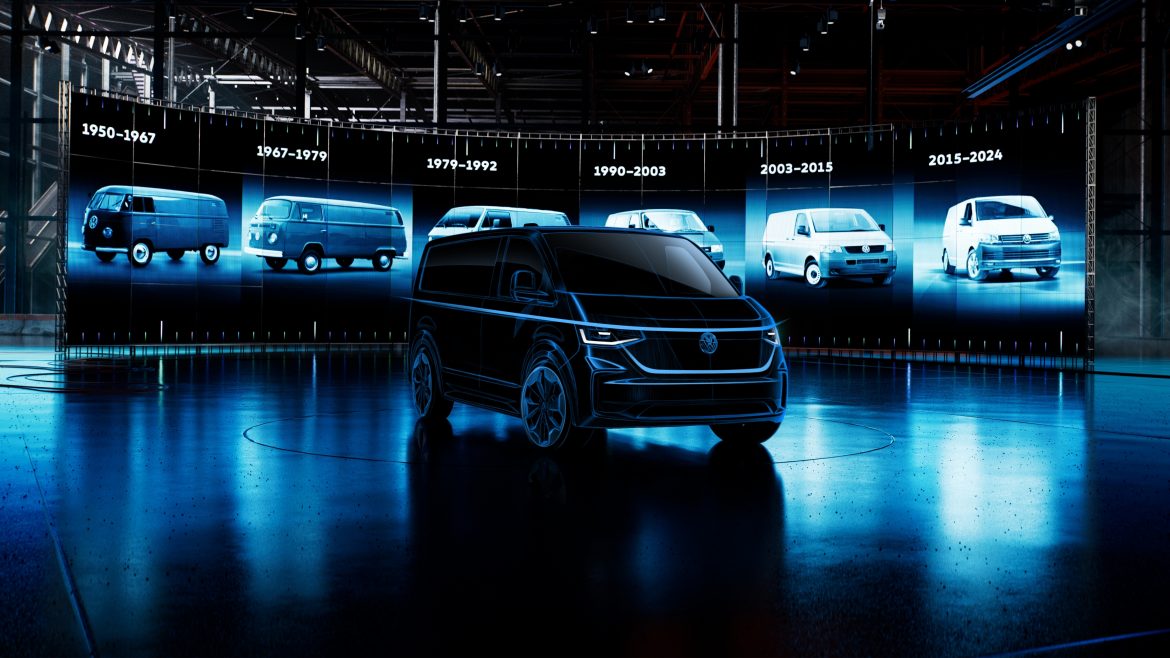While details haven’t been fully released, the new Transporter retains the familiar silhouette with a short, boxy front and steeply sloped windshield. Design cues like the signature “Bulli” line running along the side and a redesigned front grille bring it into closer visual alignment with the ID Buzz and Multivan models.
The Transporter will be available in a range of lengths between 5050mm and 5450mm, making it larger than both the ID Buzz and the Multivan. The rear features redesigned C-shaped LED lights inspired by the T5 variant, and horizontal lines on the tailgate emphasise width.
Scheduled for its official unveiling at the IAA Transportation show in Hanover this September, the Transporter is already on sale in Germany starting from EUR 36,780 (GBP 31,200). This new iteration marks a significant turning point for the Transporter, as it adopts a completely new platform co-developed with Ford. This collaboration allows the Transporter to offer electric and plug-in hybrid powertrain options for the first time. The charging port for these electrified variants is located conveniently under the right headlight.
While the exact specifications are yet to be confirmed, the Transporter will likely offer a range of wheel sizes, with the largest being 19 inches – the biggest ever offered on the Transporter. “The details of the seventh Bulli generation pick up the characteristic design features of its six predecessors and give them a new interpretation,” said Albert Kirzinger, chief designer for Volkswagen Commercial Vehicles. “This has a tradition – every new Volkswagen Transporter has always represented a new visual beginning, a bridge between its long history and the future.”
Previously spotted undergoing electric testing in Germany, the Transporter will share its platform with the Ford Transit Custom. Unlike the outgoing model, the Transporter will not be the basis for the California camper van. That model will now use the MQB-based Multivan MPV platform. The new Transporter is expected to be available in a variety of configurations similar to the previous generation, including the cargo panel van, passenger-focused Shuttle, and the Kombi with two rows of seating. A sporty Sportline trim is also a possibility.
Production will take place at the Ford Otosan factory in Turkey, and the Transporter is expected to retain its role as a significant contributor to Volkswagen Commercial Vehicles’ sales. The electric variant, likely called the E-Transporter, is expected to match the 380 km range of the Ford E-Transit Custom and offer similar powertrain options, including 136PS or 218PS rear-mounted motors.
For those seeking combustion-powered options, the Transporter will borrow the Ford Transit Custom’s engine lineup, including a 225PS plug-in hybrid, 110PS and 150PS 2.0-liter diesel engines, and an eight-speed automatic transmission. All-wheel drive will likely be an option on select trims.
While both the Volkswagen and Ford versions will share similar dimensions and prioritise manoeuvrability in urban environments, they are expected to have distinct design elements. The Volkswagen is likely to retain the same 3-metre load bay and 1360kg payload capacity found in the SWB Ford Transit Custom. The electric variant might see a slight reduction in payload capacity to 1100kg.
The official unveiling at the IAA Transportation show in September will provide a clearer picture of the new Transporter’s features and specifications. This redesigned Transporter with its electric option marks a significant step forward for Volkswagen Commercial Vehicles, catering to the evolving needs of commercial and individual users alike.



